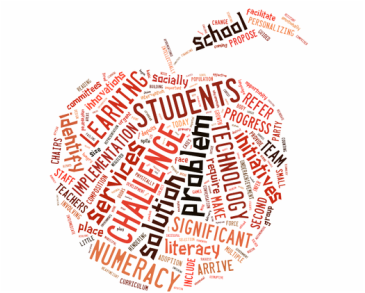One of my favourite sayings is, “No problems, just solutions.”
Educators face many challenges today. Class size and composition, reduction in funding and services, and the adoption of multiple initiatives involving curriculum and reporting.
In my current teaching position I would identify two urgent problems, or as I like to refer to them – challenges. Challenges provide an opportunity for change and growth, whereas problems infer a force hindering progress.
The first challenge is significant underachievement in literacy and numeracy. Many students arrive with significant deficits and make little progress in spite of many initiatives in place to support them such as guided reading, levelled literacy intervention, numeracy in-service and more.
The second challenge is a significant population of the student body coming through the doors physically, intellectually, emotionally and socially unprepared to learn. In many cases conversation and play that is important to language development is neglected as is building basic numeracy through counting games. Nor is it uncommon for students to arrive at school late, hungry or tired.
The first challenge would likely require a heavyweight team to design and implement a sustaining innovation solution as it crosses grade and subject areas and any initiative would likely impact all staff. Keeping in mind the SMART goals framework (Haughey, 2016) I would recommend a heavyweight team comprised of representatives from primary and intermediate grades, support services and administration and co-chaired by the chairs of the literacy and numeracy committees to be formed to meet at an agreed upon time on a monthly basis to consider instructional models and strategies and present reccomendations at the April staff committee meeting with the intention of collecting baseline data and piloting the recommendations in the 2017-2018 school year with additional data collection and analysis in April 2018 to monitor progress.
The second challenge is one that is not likely to be solved on a school level and would require an autonomous team comprised of representatives from the school district, Vancouver Island Health Authority, Ministry of Child and Family Servies and community groups such as Nanaimo Food Share, Literacy Nanaimo and other stakeholders as a starting point. The systems in place to support vulnerable families appear to be failing and I suggest the financing and delivery models of these services needs to be rethought. I propose that such a committee should be led by an impartial outside party as many of the aforementioned parties are likely to be resistant to the disruptive innovations likely required to achieve the desired results.
It is notable that neither of the challenges identified refer to technology. Technology may or may not be utilized as a solution to these challenges. Horne (2015 ) and Hudson (2013) remind us that the most successful blended learning environments have begun by identifying a broad problem. How to include technology was not the problem. It was the solution. It was a deliberate, intentional choice made in the context of a larger framework.
Much the same as KIPP charter schools use technology to facilitate the implementation of small group instruction and personalize learning, I propose that implementing a station rotation model (which is already used in several classes) can facilitate small group instruction and assist in personalizing and enriching learning and make steps towards resolving the first challenge that exists in my school. Mine is only one voice. The advantage of forming a team is that you benefit from the experience and insight of many minds whose voices may express a potential solution one individual may not have considered.
The second problem will require disruptive innovation that challenges our priorities as a society and will not be a quick or easy fix. The model may be so different from the existing one that I cannot begin to predict the form it will take. It will require a strong advocate with exceptional managerial skills to facilitate. I believe that person is out there and will one day step forward. That is my hope. That is my vision.
What’s yours?
References
Horn, Michael B and Heatyher Staker (2015) Blended: Using disruptive innovation to improve schools. San Francisco. Jossey-Boss.
Haughey, Duncan (2016). SMART Goals. Project Smart. Retrieved 22 November 2016 from https://www.projectsmart.co.uk/smart-goals.php
Hudson, Tim. (2013). How to Implement a Station Rotation Blended Learning Model. Retrieved 21 November 2016 from http://www.dreambox.com/blog/thoughts-implementing-blended-learning-models

